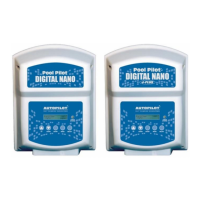Page - 44
Chemical
Ideal
Test
Schedule
Effect of Low / High Levels Corrective Actions
Free
Chlorine
Weekly
Low free chlorine: Not enough residual chlorine to
safely sanitize pool water.
Low free chlorine: Check for combined chlorine level
and shock as necessary. Increase chlorine output to
maintain a 1-3 ppm (mg/L) residual. Check stabilizer
level and add as necessary.
High free chlorine: Corrosive to metallic fixtures in
pool water. Can bleach swimwear and hair or
cause premature chlorinator cell depletion.
High free chlorine: Decrease chlorine output. Let
chlorine dissipate normally until 1-3 ppm (mg/L) is
achieved. In extreme cases, pool water can be diluted
with fresh water or a chlorine neutralizer added.
(Diluting will reduce salt and CYA. Check and adjust
as needed.)
pH Weekly
Low pH: (acidic) Equipment corrosion, eye / skin
irritation, plaster etching, rapid chlorine
consumption .
Low pH: Add sodium carbonate or soda ash.
High pH: (basic) Scale formation, cloudy water, eye
/ skin irritation, poor chlorine effectiveness.
High pH: Add sulfuric acid, muriatic acid or sodium
bisulfate.
Total
Alkalinity
Monthly
Low TA: Eye irritation, pH "bounce", stained / etched
plaster and metal corrosion.
Low TA: Add sodium bicarbonate.
High TA: Constant acid demand, difficulty in
maintaining pH, and contributes to scale formation
or cloudy water conditions.
High TA: Add sulfuric acid, muriatic acid often or
sodium bisulfate more frequently until the TA is within
an acceptable range.
Calcium
Hardness
Monthly
Low CH: Etching of the plaster, equipment
corrosion.
Low CH: Add calcium chloride flakes.
High CH: Scale formation, cloudy water. Rapid
buildup of scale may exceed the system's self-
cleaning capability and require manual cleaning of
the cell.
High CH: Partially drain and refill pool with fresh water
to dilute. (Diluting will reduce salt and CYA. Check
and adjust as needed.)
Cyanuric
Acid (CYA
or
Stabilizer)
Monthly
Low CYA: Destruction of chlorine by the UV rays
from the sun.
Low CYA: Add Cyanuric acid (1 lb.(0.45 kg) per 5,000
gallons (18,930 liters) increases CYA 25 ppm (mg/L).
High CYA: Requires more chlorine to maintain
proper sanitizer levels. Note: CYA not needed for
indoor pools or bromine pools. CYA can be
reduced to 30 - 50 ppm (mg/L) for colder climate
regions.
High CYA: Partially drain and refill pool with fresh
water to dilute. (Diluting will reduce salt. Check and
adjust as needed.)
Saturation
Index
Monthly
+ 0.3: Water is scale forming. Calcium carbonate is
falling out of solution. This rapid buildup of scale
may exceed the system's self-cleaning capability
and require manual cleaning of the cell.
Balance the pool / spa water as close to an
equilibrium of 0 as possible. See "Using the
Saturation Index" on page 46.
- 0.3: Water is corrosive. Water will take away other
material it comes in contact with to form a natural
balance. These materials can be metallic fixtures,
swimwear, etc. Results can also include cloudy
water, eye / skin irritation, and poor chlorine
effectiveness.
Balance the pool / spa water as close to an
equilibrium of 0 as possible. See "Using the
Saturation Index" on page 46.
Salt Monthly
Low Salt: Below 2,400 ppm (mg/L) causes
premature cell failure and reduces chlorine
production .
Low Salt: Add salt according to digital display on Pool
Pilot unit or salt chart.
High Salt: Above 6,000 ppm (mg/L) can cause
corrosion of metallic fixtures and will taste salty.
Note: The Pool Pilot
®
can safely operate with salt
levels up to 35,000 ppm (mg/L).
High Salt: If undesirably high, partially drain and refill
the pool with fresh water. (Diluting will reduce CYA.
Check and adjust as needed.)
Table 8

